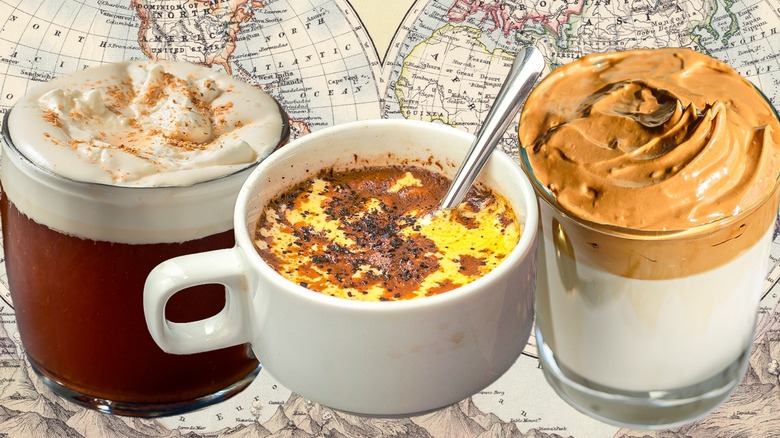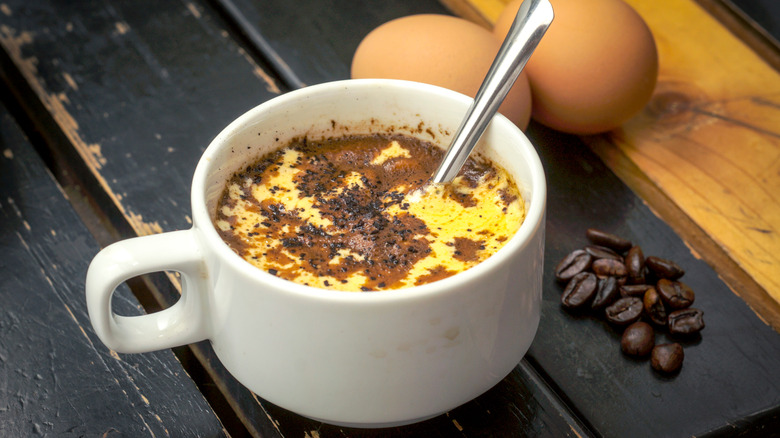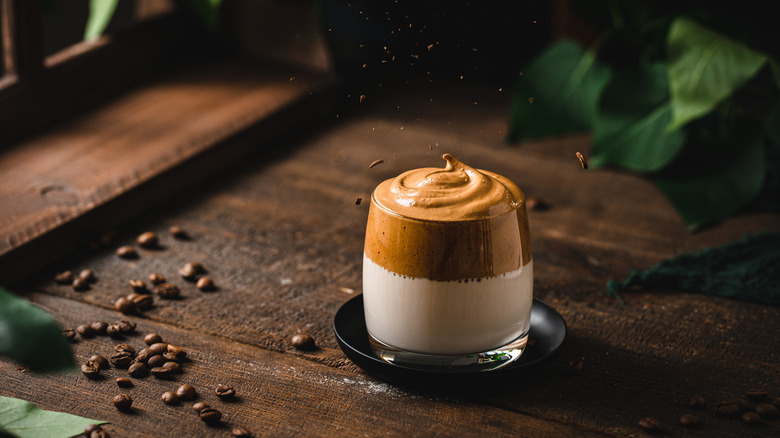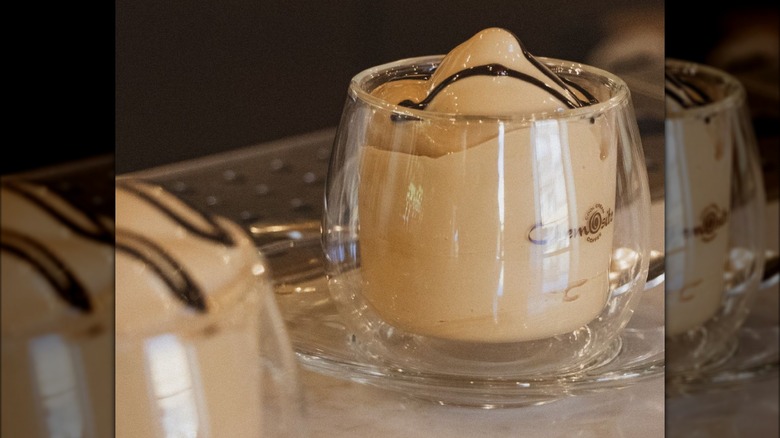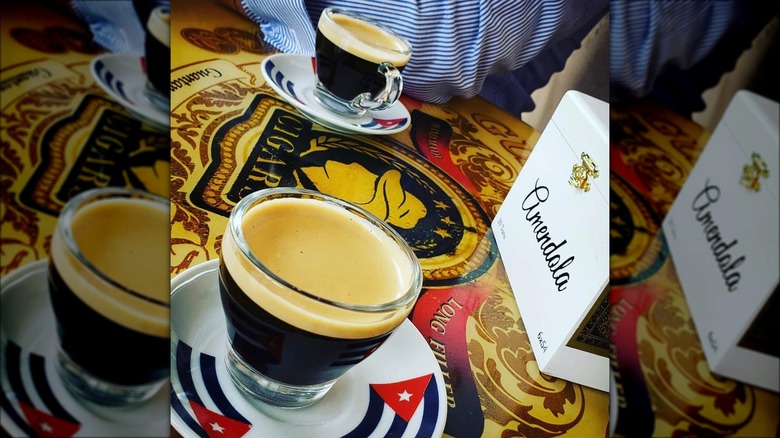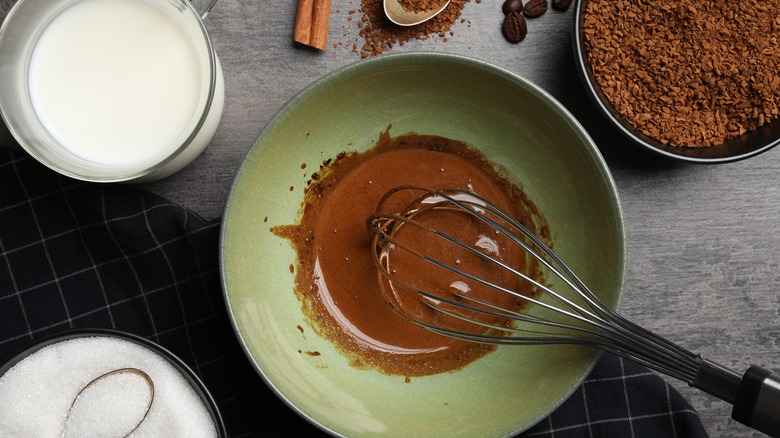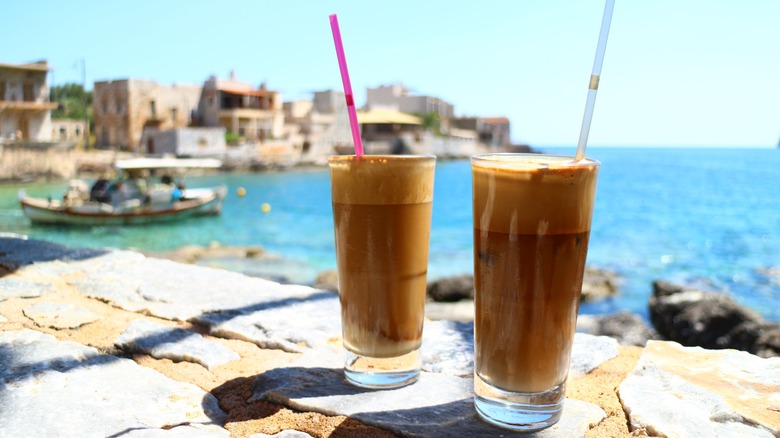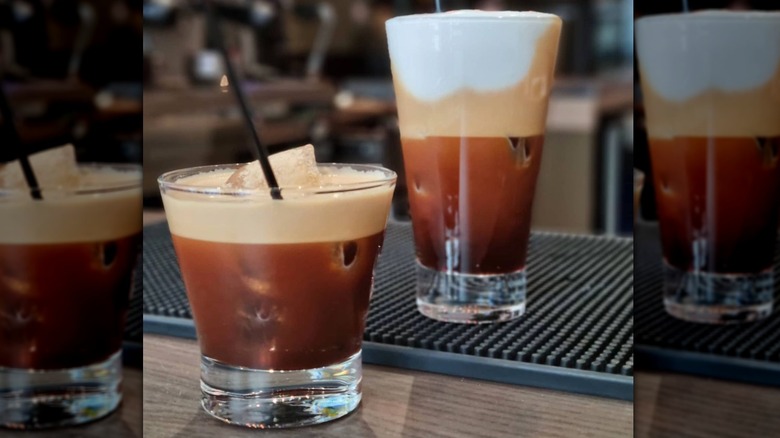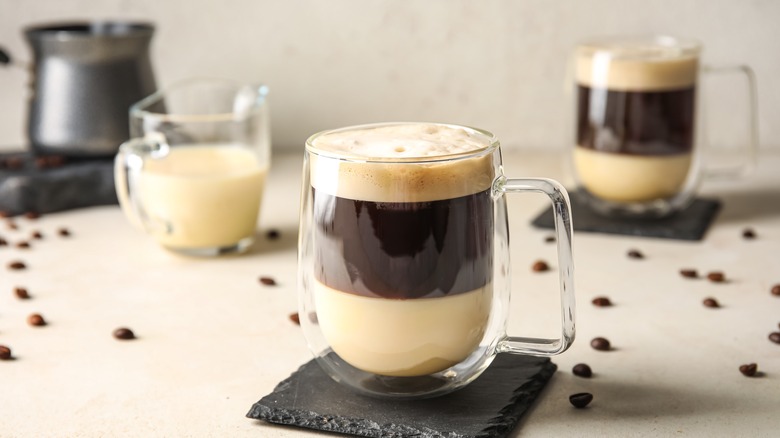9 Whipped Coffees From Around The World You Should Know
Of all social media-fueled trends to emerge from the coronavirus pandemic, the whipped coffee craze has to be one of the most appealing to caffeine lovers. It's a simple enough concept, using foam or froth to jive up your java. Whether your taste favors the sweet and decadent or the rich and robust, there's likely a way to whip up an improved version of your favorite type of coffee.
In fact, the so-called trend of whipped coffee is in no way a new concept. All over the world, various cultures have developed their own distinctive versions of whipped coffee. Some regions boast cold and refreshing beverages, while others champion warmer brews topped with whipped foam. Many whipped coffees come from countries bolstering long and storied relationships with coffee production. Others have developed a more contemporary obsession with the drink that the rest of the world can now enjoy.
Ultimately, the world has no shortage of foamy, frothy, silky, or bubbly whipped coffees that elevate a simple drink into an experience greater than the sum of its parts. The ingredients in these beverages are often similar, combining coffee, sugar, and milk in unique ways that add texture and shape to the brew.
Vietnamese egg coffee
Cà phê trúng, or Vietnamese egg coffee, offers a unique experience to explorers through the world of coffee. What makes this coffee unique is the whipped custard-like foam that tops it, made of sweetened condensed milk and, of course, egg yolk. Since the late 1850s, when French colonists began growing coffee in Vietnam, the country has been developing its unique coffee culture, including egg coffee.
According to Japanese Coffee Co., the drink was invented in the mid-1940s, and as the legend goes, a man named Nguyen Van Giang worked in a French hotel when he invented the drink. Due to dwindling and overpriced milk supplies, Giang came up with the idea of using eggs instead, resulting in a pleasant, creamy-textured froth. The drink was a huge success, and in 1946, Giang championed the coffee within the walls of Café Giảng, his own coffee shop.
Since then, cà phê trúng has gained popularity in the streets of Hanoi and on social media, where the visually appealing whipped coffee has attracted much attention. In appearance, egg coffee has a distinctive golden-brown foam top, which sits neatly over a rich layer of strong black coffee. To enjoy, you can either stir these two layers together to enjoy a sweet and creamy drink or sip the black coffee through the foam top. The taste of the drink is said to be similar to tiramisu, with the sweet custard-like foam complementing the bitter coffee.
Korean dalgona coffee
Dalgona coffee is a cold, sweet, and visually impressive beverage that has become the face of whipped coffees around the world. A quick internet search for "whipped coffee" returns page after page raving about dalgona coffee with images of cold milk topped with decadent coffee foam.
Dalgona coffee is said to have gained immense online popularity when Jung Il-woo, a popular South Korean actor, enjoyed the whipped beverage in a cafe in Macau while filming a program, according to South China Morning Post. The coffee resembles the flavor of the popular Korean dalgona honeycomb candies (made famous by the Netflix series "Squid Game"), so the name stuck, and the internet quickly jumped on the new whipped coffee fad. Now, the popularity of dalgona coffee is a persistent remnant of the COVID-19-era trend. The beverage has become closely associated with South Korea.
The science behind dalgona coffee is simple, as is the process of making it. With only a few ingredients, namely instant coffee, sugar, milk, and water, it's something many people can whip up with what's already in their pantries. Just whip the instant coffee, water, and sugar into a smooth foam and layer it over a glass of milk with ice. As you drink this tasty beverage, the coffee foam mixes with the milk to create a delicious and refreshing whipped coffee.
Italian crema di caffè
When tourists fantasize about Italian coffee, they likely picture the quintessential image of standing at the bar or sitting at tables enjoying small cups of espresso. What many may not realize, however, is that Italy also has a delicious summertime alternative to espresso. This is the refreshing crema di caffè. Another common name for these that you might find around Italy is crema fredda al caffè.
Crema di caffè is a sweet, cold whipped coffee that many restaurants, bars, and tabacchi (a convenience store crossed with bar and cafe) serve to those seeking escape from the heat of Italian summer. Just as with normal espresso, these are also served in the same small cups. Rather than sipping, customers enjoy crema di caffè with a spoon, as it's quite thick.
In Italy, bartenders or baristas may serve these from large mixers behind the bar, but it's also easy to prepare at home. You can make your own crema di caffè by whipping together strong, chilled, sugar-sweetened coffee and cold whipping cream. Serve in a small glass or cup, and top with cocoa powder or cinnamon if that suits your taste.
Café Cubano
While dalgona coffee has been holding the whipped coffee limelight since the lockdown era, there is another traditional coffee that boasts a frothy coffee and sugar concoction. Cuban coffee, also called café Cubano, has differences with dalgona, although there are also notable similarities.
Café Cubano is a strong, foamy coffee made by combining espresso and demerara or brown sugar. The foam is traditionally created by combining a small amount of espresso and demerara sugar and stirring intensely until it produces a rich coffee froth, known as espuma. After creating the foam, the maker pours espresso into the small cup to create a strong, espresso-sized coffee topped with sweet, rich froth. The traditional process for brewing the espresso for this drink is to use an Italian stovetop moka pot espresso maker, which produces strong dark coffee. This is a far stronger coffee than dalgona coffee, as well as being a hot beverage. For those wanting a colder beverage, a creamy iced Cuban coffee with a splash of sweetened condensed milk goes down smoothly on a hot day.
Café Cubano is a common accompaniment to breakfast, or when eating or taking a break at different times of day. As with Italian espresso, it's common for Cubans to socialize while enjoying café Cubano.
Pakistani phitti hui
Phitti hui, which translates to "beaten coffee," is the traditional Pakistani version of whipped coffee. Using instant coffee, sugar, and water, this is similar to many other popular whipped coffees that have captured the interest of coffee lovers around the world.
The traditional method for preparing this coffee involves whipping the coffee, warm water, and sugar together with a spoon, although modern-day preparation certainly forgives an electric beater. Despite the similarities in preparing the foam this way, phitti hui is usually enjoyed warm, rather than on ice, distinguishing it from other whipped coffees such as dalgona coffee. After whipping up the foam, add hot water and milk into the cup to your liking. A gentle stir mixes the beverage while leaving the foam light and frothy on the top.
The resulting drink is a satisfyingly sweet and warm drink with that same appealing silky whipped coffee topping. These coffees can even be found in machines in Pakistan, but are also common drinks to prepare at home.
Indian beaten coffee
A variation of Pakistan's phitti hui is Indian beaten coffee. Another common name for this style of whipped coffee is Indian cappuccino, because of how the whipped top of the beverage resembles the foamed milk on the top of an Italian cappuccino. These can also be called hand-beaten coffees because of the traditional method of beating the coffee to whip the foam. Other names include desi coffee or soft coffee, but all these different names mean the same thing, a warm, sweetened whipped coffee.
Indian beaten coffee is popular in North Indian homes, but can also be enjoyed publicly in coffee houses of this region as well as other areas. This drink is also key to Indian wedding ceremonies and other important gatherings.
The process of making this coffee is as simple as with its Pakistani counterpart. In fact, the preparation steps are the same. Making this coffee involves whipping instant coffee with sugar and water, before adding in warm milk or water to your liking. Although one of the names of this drink is hand-beaten coffee, using an electric beater can still make this step simpler and result in fluffier, smoother whipped coffee foam.
Greek frappé
While the word frappé may evoke images of trendy iced beverages, sipped over laptops in your local Starbucks, this cold whipped coffee has interesting roots in Greece. In fact, there are several major differences between the frappé and the frappuccino, with which you may be more familiar.
The history of the frappé is not a long one, with the drink first emerging in 1957 as a happy accident due to a Nestlé employee exhibiting an innovative shaken chocolate drink at the Thessaloniki Trade Fair. The employee didn't have hot water for his instant coffee, so tried the new shaker method with cold water and ice. In doing so, he inadvertently invented the world's first frappé.
Today, the Greek frappé is a ubiquitous way to beat the heat with a drink that's both refreshingly cold and stimulatingly caffeinated. Shaking the drink with ice generates an enjoyable foam and cools down the ingredients. These are simple — just water, instant coffee, and if you prefer, milk. Customers typically choose how they want their frappés, whether sweeter, more bitter, or milky. This milk can be either normal milk or evaporated milk.
Frappés are extremely common throughout Greece and also Cyprus. In fact, it has been heralded as the national coffee drink of Greece since approximately 1979, further solidifying its place as one of the world's favorite whipped coffees.
Greek freddo
While the Greek frappé has enjoyed the limelight, its younger espresso-based counterpart has also been a local favorite since around the mid-'90s, after the introduction of espresso into the regional coffee culture took hold. The freddo espresso is the iced, Greek version of the frappuccinos that have made a place for themselves around the world.
Making freddo espresso involves adding a freshly drawn double espresso shot to a shaker with your desired level of sugar, and shaking well with ice. Next, the maker pours the foamy coffee over ice to be enjoyed with a straw. This can be a refreshingly bitter whipped coffee, or sweeter if that's your preference.
Freddo cappuccino involves the same process of whipping espresso in a mixer with ice but adds a final stage of layering whipped milk foam on top. As with the freddo espresso, sweetness is down to personal taste, which determines how much sugar to add. The sugar is added to the hot espresso shot and stirred before shaking with ice.
Spanish café bombón
One of the sweetest whipped coffees is the Spanish café bombón, the name of which even translates to "confection." This is a popular coffee to enjoy throughout Spain, having first emerged in Valencia.
What gives this coffee its signature sweetness is the use of evaporated milk in place of normal milk. Unlike other whipped coffees in this list, rather than preparing the drink by whipping ingredients together, common versions of the café bombón are somewhat deconstructed. The coffee, condensed milk, and sugar are presented in distinctive layers.
A popular way to make this coffee involves vanilla-enhanced whipped cream to top the drink off. This can be created ahead of time by whipping up the cream with vanilla extract with an electric beater or by hand. The coffee is assembled by pouring a bottom layer of condensed milk, followed by a double shot of espresso. Another method for this stage is to draw the espresso in the glass and carefully pour the heavier condensed milk into it, allowing it to sink down the side to the bottom forming a solid white layer. Using a glass allows for this layering effect to make the beverage even more appealing. The coffee is finished with a final layer of vanilla whipped cream. Enjoy this coffee by stirring these layers together, making this deconstructed whipped coffee into one sweet, hot, and foamy beverage.
